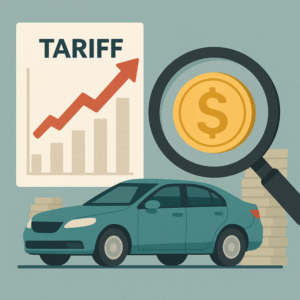A 5.6% Yield From Ford: Attractive Dividend Stock to Buy or Hidden Trap?
Ford Motor Company (NYSE: F) has long been a staple in the automotive industry, but in recent years, it has transformed its business model to adapt to the ever-changing market dynamics. One of the most compelling reasons investors are paying attention to Ford today is its attractive dividend yield of 5.6%. However, the question remains: Is this yield a sign of a strong investment opportunity, or is it a hidden trap waiting to ensnare unsuspecting investors? In this article, we will delve into the factors influencing Ford’s dividend, the potential risks, and whether it is worth considering as part of your investment portfolio.
Understanding Ford’s Dividend Yield
Ford’s current dividend yield of 5.6% is certainly enticing, especially when compared to the average dividend yield in the broader market. But what exactly does this yield represent?
What is Dividend Yield?
Dividend yield is a financial ratio that shows how much a company pays out in dividends each year relative to its stock price. It’s calculated as:
Dividend Yield = Annual Dividends per Share / Price per Share
A high dividend yield can be attractive as it indicates that investors receive a substantial return on their investment in the form of regular payments. However, it’s essential to evaluate why the yield is high, as it can sometimes be a red flag.
Ford’s Dividend History
Ford reinstated its dividend in 2021 after suspending it during the pandemic to conserve cash. Since then, the company has steadily increased its quarterly payments, reflecting optimism about its recovery and future growth. Investors should consider:
– The sustainability of the dividend
– The company’s cash flow and earnings stability
– Historical performance and payout ratio
Ford’s commitment to returning value to shareholders through dividends has made it an attractive option for income-focused investors. Yet, the automotive market is notoriously volatile, and investors must tread carefully.
Factors Influencing Ford’s Dividend Sustainability
Several key factors contribute to Ford’s ability to maintain its dividend payments and potentially increase them in the future.
1. Strong Revenue Growth
Ford has been working hard to adapt to the electric vehicle (EV) revolution, introducing models such as the Ford Mustang Mach-E and the all-electric Ford F-150 Lightning. The company has invested heavily in EV technology, anticipating substantial growth in this sector, which could lead to increased revenues and profitability.
2. Cost Management Initiatives
The company has initiated numerous cost-cutting measures to streamline operations and improve margins. These initiatives are designed to enhance efficiency and redirect capital toward innovation and shareholder returns.
3. Global Supply Chain Resilience
The automotive industry has faced significant challenges due to supply chain disruptions, particularly during the COVID-19 pandemic. Ford has worked diligently to improve its supply chain resilience, which is crucial for maintaining production levels and meeting consumer demand.
Risks Involved with Ford’s Dividend
While there are positive indicators for Ford’s dividend sustainability, several risks must be considered before diving into this investment.
1. Market Volatility
The automotive market is cyclical, and Ford is not immune to economic downturns or changes in consumer preferences. A decline in vehicle sales or adverse economic conditions could negatively impact the company’s revenues and, consequently, its ability to sustain dividends.
2. Competition in the EV Market
The race toward electric vehicles is becoming increasingly competitive, with traditional rivals and new entrants vying for market share. Ford needs to continuously innovate and stay ahead to capture consumer interest in EVs while also maintaining profitability.
3. High Debt Levels
Ford carries a significant amount of debt, which can be concerning for investors. While the company has made strides in paying down debt, high leverage can limit financial flexibility and increase risk, particularly if market conditions worsen.
Evaluating Ford as a Long-Term Investment
When considering Ford as part of your long-term investment strategy, assessing the overall market environment and the company’s position within it is vital.
1. Industry Trends
The shift toward electric and autonomous vehicles is reshaping the automotive landscape. Ford’s proactive approach to embrace these changes may position it favorably against competitors. Investors should monitor industry trends and Ford’s ability to keep pace.
2. Financial Health
Analyzing Ford’s financial health through key metrics such as revenue growth, earnings per share (EPS), and cash flow will provide insight into its operational effectiveness. The company’s commitment to improving its balance sheet is essential for stability.
3. Diversification
Investing in Ford should be part of a diversified portfolio. Relying solely on one stock for dividend income poses risks. Diversifying across various sectors and asset classes can help mitigate potential losses while still capturing opportunities for growth.
Conclusion: Attractive Dividend Stock or Hidden Trap?
Ford’s 5.6% dividend yield is undoubtedly attractive, making it a compelling option for income-seeking investors. However, it is crucial to weigh the potential for sustainable growth against the risks present in the automotive industry.
Investors should take a holistic approach, considering both the company’s initiatives and market conditions before making investment decisions. Ford has the potential for long-term growth, particularly in the EV sector, but it also carries risks that cannot be overlooked.
Ultimately, whether Ford is an attractive dividend stock or a hidden trap lies in your investment strategy, risk tolerance, and commitment to staying informed about market trends and the company’s performance. As always, thorough research and analysis are key to making sound investment choices.



